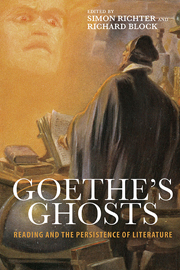Book contents
- Frontmatter
- Contents
- Introduction—Ghosts and the Machine: Reading with Jane Brown
- Part I The Ghosts of Goethe's Past
- Part II The Ghost That Keeps on Giving
- Part III Spirited Encounters
- 11 The Imagination of Freedom: Goethe and Hegel as Contemporaries
- 12 Effacement vs. Exposure of the Poetic Act: Philosophy and Literature as Producers of “History” (Hegel vs. Goethe)
- 13 Toward an Environmental Aesthetics: Depicting Nature in the Age of Goethe
- 14 “Ein heimlich Ding”: The Self as Object in Annette von Droste-Hülshoff
- 15 “Ja, Goethe über alles und immer!”: Benn's “Double Life” in His Letters to F. W. Oelze (1932–56)
- Bibliography of Jane K. Brown's Publications
- Notes on the Contributors
- Index
14 - “Ein heimlich Ding”: The Self as Object in Annette von Droste-Hülshoff
from Part III - Spirited Encounters
Published online by Cambridge University Press: 05 March 2014
- Frontmatter
- Contents
- Introduction—Ghosts and the Machine: Reading with Jane Brown
- Part I The Ghosts of Goethe's Past
- Part II The Ghost That Keeps on Giving
- Part III Spirited Encounters
- 11 The Imagination of Freedom: Goethe and Hegel as Contemporaries
- 12 Effacement vs. Exposure of the Poetic Act: Philosophy and Literature as Producers of “History” (Hegel vs. Goethe)
- 13 Toward an Environmental Aesthetics: Depicting Nature in the Age of Goethe
- 14 “Ein heimlich Ding”: The Self as Object in Annette von Droste-Hülshoff
- 15 “Ja, Goethe über alles und immer!”: Benn's “Double Life” in His Letters to F. W. Oelze (1932–56)
- Bibliography of Jane K. Brown's Publications
- Notes on the Contributors
- Index
Summary
What does it mean to think “I,” to say “I,” to write “I”? These foundational questions of subjectivity inform Annette von Droste-Hulshoff's literary production to such an extent that one might arguably define her oeuvre in terms of the early German Romantic notion of autopoiesis, the self-reflexive, self-critical self-creation of the subject, das Ich (the I), in and through poesy. Yet in contradistinction to the unitary structure of early Romantic subjectivity, for Droste the self frequently is presented as an object, an object often watched by—and at times watching—the subject, an object that is irreconcilable with the subject. significantly, many of these scenes of objectified self-definition are explicitly presented as aesthetic events, indicating their programmatic status in Droste's poetics, and they recur emblematically throughout her writing.
The following analysis seeks to elucidate Droste's object-driven conception of subjectivity and poetic production through a series of examples. The first section considers the early prose fragment Ledwina (1818/19–26). The second presents brief readings of a selection of her more famous poems and ballads, written between 1840 and 1844: “Das Spiegelbild” (The mirror image), “Im Moose” (In the moss), “Das Fraulein von Rodenschild” (Lady von Rodenschild), “Das erste Gedicht” (The first poem), “Das alte schloss” (The old castle), “Im Grase” (In the grass), “Die todte Lerche” (The dead lark), “Die Taxuswand” (The yew wall), “Die Mergelgrube” (The marl pit) and “Lebt wohl” (Farewell).
- Type
- Chapter
- Information
- Goethe's GhostsReading and the Persistence of Literature, pp. 276 - 289Publisher: Boydell & BrewerPrint publication year: 2013



